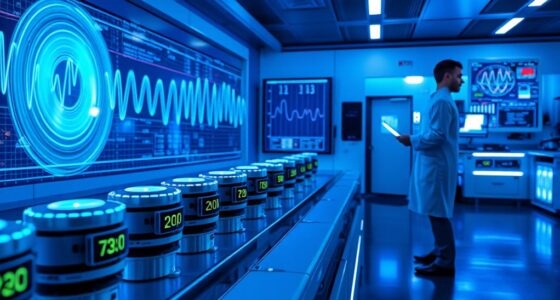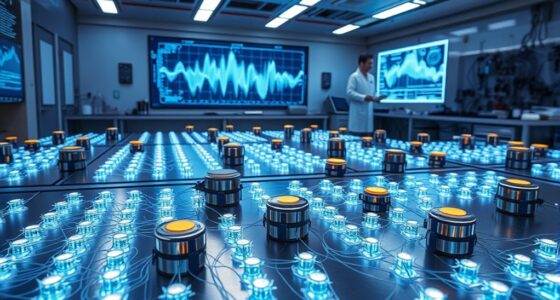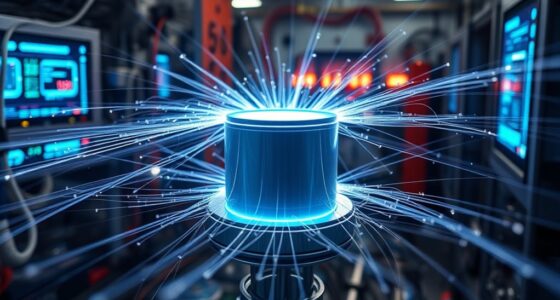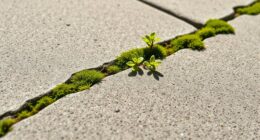Bio-inspired concrete that heals its own cracks can revolutionize urban infrastructure by providing self-repairing, long-lasting structures. It uses microcapsules with healing agents that react when cracks form, sealing and preventing further damage. This technology reduces maintenance costs, minimizes disruptions, and promotes sustainability by extending infrastructure lifespan. Cities adopting this concrete can become smarter and more resilient. If you want to discover how this innovation shapes the future of urban development, continue exploring its potential.
Key Takeaways
- Self-healing concrete uses microcapsules with healing agents to automatically repair cracks, reducing maintenance needs.
- It enhances urban infrastructure durability, prolonging lifespan and lowering repair costs for roads, bridges, and buildings.
- Environmentally friendly, this technology minimizes waste and carbon emissions by decreasing frequent rebuilds and repairs.
- Self-repairing concrete promotes resilient city environments, supporting smarter, sustainable urban development.
- This innovation enables infrastructure to monitor and maintain itself, transforming urban planning and infrastructure management.
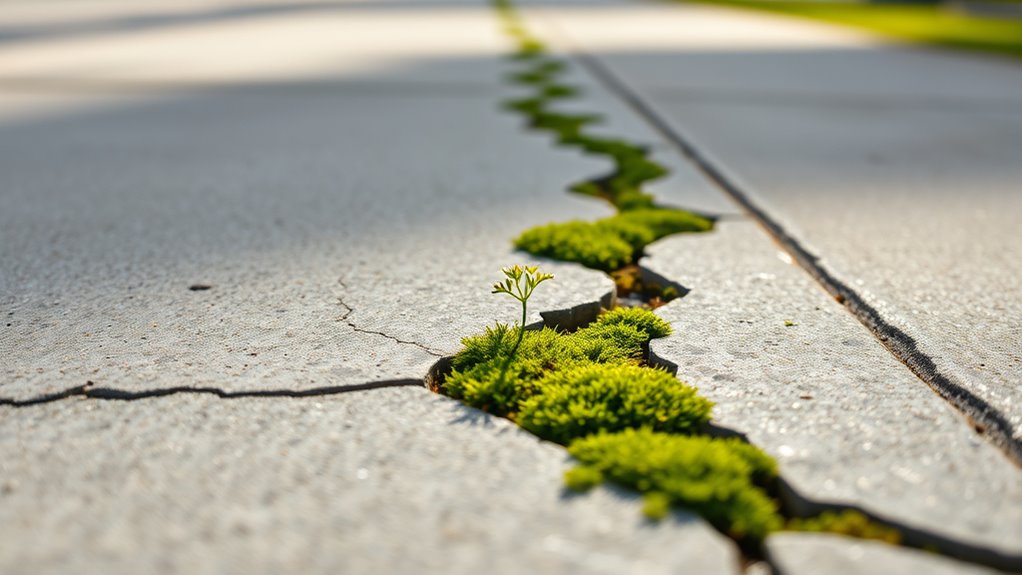
Imagine a concrete that can repair its own cracks without human intervention—sounds like science fiction, but it’s becoming a reality thanks to bio-inspired innovations. This remarkable development involves self-healing materials, which mimic natural processes to detect and mend damage automatically. Instead of costly repairs and disruptive construction work, cities could soon enjoy infrastructure that maintains itself, reducing maintenance costs and extending the lifespan of roads, bridges, and buildings. This approach aligns closely with sustainability innovations, aiming to make urban environments more durable and eco-friendly.
By integrating microcapsules filled with healing agents into concrete, engineers enable the material to respond proactively when cracks form. When a crack occurs, it breaks these capsules, releasing substances that fill and seal the damage. This process not only prevents further deterioration but also reduces the need for frequent repairs, conserving resources and minimizing waste. As a result, city infrastructure becomes more resilient and less vulnerable to weathering, traffic loads, or other stressors.
Self-healing concrete releases healing agents to automatically repair cracks, reducing maintenance and extending infrastructure lifespan.
What excites you about self-healing concrete is its potential to revolutionize urban planning. Imagine roads that stay smooth longer, reducing vehicle damage and accident risks, or bridges that naturally repair minor cracks before they escalate into major failures. These innovations lead to safer, more sustainable cities that require fewer interventions, lowering carbon footprints associated with maintenance and reconstruction. *Furthermore*, the materials used in bio-inspired concrete often incorporate environmentally friendly components, making them a key part of sustainable development.
This technology also encourages smarter, more adaptive cityscapes. As urban areas grow, infrastructure faces increasing pressure. Self-healing materials help address these challenges by providing a proactive maintenance solution, rather than reactive repairs. You could see entire streets and structures that monitor their health and automatically heal themselves, reducing downtime and disruption. This approach aligns with the broader goal of creating greener cities that are resilient against climate change and aging infrastructure.
In essence, bio-inspired concrete that heals its own cracks represents a significant leap forward in urban sustainability innovations. It offers a practical way to extend the lifespan of your city’s infrastructure while minimizing environmental impact. As this technology advances and becomes more widespread, you’ll notice smarter, longer-lasting cities that are better equipped to face future challenges—all thanks to the marvels of nature-inspired engineering. Additionally, ongoing research into self-healing materials continues to expand potential applications across various sectors, enhancing overall urban resilience and sustainability.
Frequently Asked Questions
How Long Does Self-Healing Concrete Typically Last?
You might wonder how long self-healing concrete lasts. Typically, its material durability depends on longevity factors like environmental conditions and usage. While standard concrete can last 50-100 years, self-healing variants often extend this lifespan by automatically repairing cracks, reducing deterioration. However, the exact duration varies with application and maintenance. Overall, self-healing concrete can markedly improve longevity, making your structures more resilient and reducing the need for frequent repairs.
Is Bio-Inspired Concrete More Cost-Effective Than Traditional Concrete?
You might wonder if bio-inspired concrete is more cost-effective than traditional concrete. Generally, the cost comparison depends on manufacturing costs, which are often higher initially due to advanced materials and processes. However, over time, it can save you money because of reduced repair needs and longer durability. While the upfront costs are higher, the long-term savings and benefits might make bio-inspired concrete a smart investment for your projects.
Can This Concrete Be Used in All Weather Conditions?
Weather worries you, but this wonder material wows you. You’ll find that bio-inspired concrete boasts impressive weather resilience and climate adaptability, meaning it can handle diverse conditions—from scorching heat to freezing freeze. Its innovative design helps it heal cracks and withstand weather fluctuations, making it a reliable, resilient choice in all weather conditions. You can confidently depend on it to perform perfectly, no matter what the climate throws your way.
What Are the Environmental Impacts of Producing Bio-Inspired Concrete?
When considering the environmental impacts of producing bio-inspired concrete, you should focus on its sustainable manufacturing processes. This concrete often has a smaller ecological footprint compared to traditional options because it uses eco-friendly materials and reduces maintenance needs. By choosing this innovative material, you help lower resource consumption and waste, making your projects more environmentally responsible and contributing positively to urban sustainability efforts.
How Does Self-Healing Concrete Affect Urban Infrastructure Maintenance?
When you use self-healing concrete in urban infrastructure, you markedly reduce maintenance needs. It enhances material durability, meaning roads, bridges, and buildings last longer without frequent repairs. This innovation influences urban planning by allowing cities to allocate resources more efficiently. With fewer disruptions, your city stays safer and more functional, ultimately saving money and reducing environmental impacts while improving the resilience of critical infrastructure.
Conclusion
Imagine walking through a city where roads and sidewalks repair themselves after every crack or chip. You’d see fewer disruptions, less maintenance, and safer streets. Some might think it’s a futuristic dream, but bio-inspired concrete makes this possible now. Just like living organisms heal wounds, this concrete seals its own fractures, keeping your city resilient and beautiful. So, next time you notice a crack, remember—future cities might be a lot more alive than you think.



